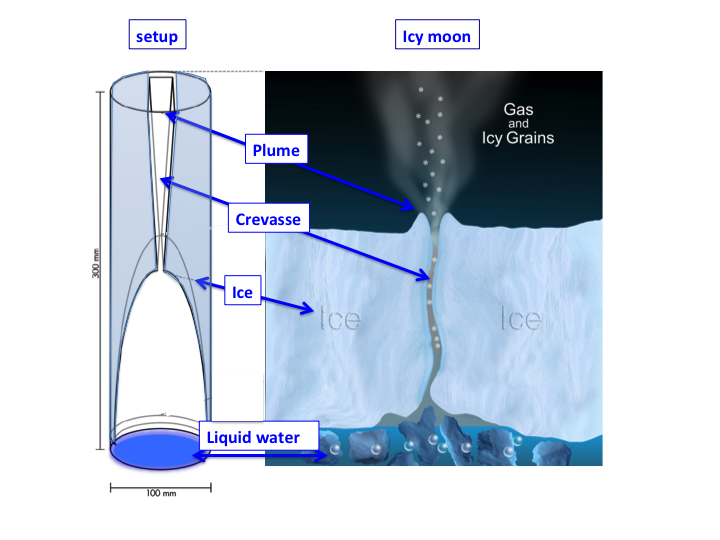Icy moons’ geysers: from laboratory to theory
- 1TU Delft, Aerospace Engineering, Planetary exploration, Netherlands (s.m.cazaux@tudelft.nl)
- 2Leiden Observatory, Leiden University, P.O. Box 9513, NL 2300 RA Leiden, The Netherlands
The Cassini mission revolutionized our vision on the habitability of our solar system. While the icy moons orbiting Jupiter and Saturn were supposed to be cold and inert objects well outside the habitable zone (where water can be found liquid), Cassini showed that Saturn's moon Enceladus is very active, with a warm interior heated by tidal forces (Choblet et al. 2017), allowing the presence of an ocean under a km-thick icy crust (Thomas et al. 2016). This ocean escapes through geysers (plumes) from the icy surface. Cassini performed many fly-bys through the plumes, measuring their composition and characteristics and showed that the ocean under the icy crust is salty, fed by ongoing hydrothermal activity (Postberg et al. 2009, 2011) and contains COMs, i.e. complex organic molecules (Postberg et al. 2018). Another characteristic of the plumes is their very large velocities, reaching 700-900 m/s (Yeoh et al. 2016), highlighting that plumes are due to expansion of the gas through a nozzle like crevasse. The plumes are supposed to represent the composition of the Ocean, but how plumes and the ocean are linked has been addressed by theories (Yeoh et al. 2015; Schmidt et al. 2008) but not yet experimentally. While the data provided by Cassini gave rise to many possible theories and scenarios, the latest data have been taken in 2017 and we will have to wait many years before Europa Clipper and JUICE are able to further investigate icy moons. The measurements from Cassini left us with many unanswered questions: How are the plumes' characteristics linked to the subsurface ocean? Is there life on Enceladus? And if yes, could you see it in the plumes and how would you detect it? By recreating plumes in laboratory, supported by theoretical modeling, we aim to apply reverse engineering by understanding how the characteristics of the plumes, which has been extensively observed by Cassini, can provide constrains on the characteristics of the sub-surface ocean.
We developed a setup to verify experimentally that under the icy moon’s conditions (pressure, temperature) a plume reaches hypersonic/supersonic velocities, and determined how the ocean (liquid water) translates into plumes. We designed and build a reservoir where liquid water can be frozen, mimicking the moon’s icy crust. A mould, introduced in the reservoir and removed once the water is frozen, simulates the crevasse. The mould is designed such as to establish the hypersonic/supersonic velocities in the plumes. The bottom of the reservoir contains liquid water corresponding to the subsurface ocean. The experimental setup is shown in the picture in Figure 1. We performed several experiments showing how plumes are generated in this setup and we measured the plumes' characteristics under different experimental conditions. The experiments were performed at the wind tunnel laboratories where Particle Image Velocimetry (PIV) techniques can be used to track whether particles present in the liquid water can be also found in the plumes. These experiments allowed to determine the characteristics of the plumes as well how they relate to the liquid water. Theoretical modeling based on models from Schmidt et al. (2008), have been developed to support and interpret experimental results. This model can predict the nucleation of water under experimental conditions and the formation of water clusters in the experiments. This model, benchmarked by our experimental results, can be extended to icy moons environments on large scale and compared to plumes observed withthe Cassini mission.

Figure 1: Sketch of the experimental setup mimicking the icy moon’s icy crust, ocean and plumes.
Bibliography:
Choblet et al. 2017, Nat Astron 1, 841847
Thomas, P.C. et al 2016 Icarus 264, 37
Postberg, F. et al. 2009 Nature 459, 1098
Postberg, F. et al. 2011, Nature 474, 620
Postberg, F. et al. 2018a, Nature 558, 564
Schmidt et al. 2008, Nature 451, 685
Yeoh et al. 2015 Icarus 253, 205;
How to cite: Cazaux, S., Sklavenitis, S., Bründl, T., van der Hijden, N., and Schrijer, F.: Icy moons’ geysers: from laboratory to theory, Europlanet Science Congress 2021, online, 13–24 Sep 2021, EPSC2021-404, https://doi.org/10.5194/epsc2021-404, 2021.

